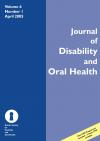Journal of Disability and Oral Health

- Cover Date:
- April 2005
- Print ISSN:
- 1470-8558
- Electronic ISSN:
- 1754-2758
- Vol:
- 6
- Issue:
- 1
Editorial - Emily is Emily
My youngest daughter Emily is nearly 4 years old, she, like many other little girls of her age attends nursery, has swimming lessons and enjoys weekly ballet classes. She, like her older sister Katie, enjoys playing with a range of toys and participates in a range of family activities such as trips to the zoo, the park and to the leisure centre. Just like all other children she has a totally individual personality. Emily, however, is different to many little girls her age in that she has Down syndrome. Emily was diagnosed as having Down syndrome when she was six days old and one of my initial reactions to this news was of concern for Emily, was her life going to be difficult? How would she manage when I was no longer around? I didn’t have many pre-conceived ideas about what her life would be like but at only a few days old I was already worrying about whether she would be safe and whether she would be able to have children. I assumed that, even though she may well live independently, she would need support from me. When I sat down and thought more clearly about these worries they probably weren’t much different to those I could have had about my other daughter, Katie. The difference was, when Katie was six days old I wasn’t thinking that far into the future. What I wasn’t prepared for were the low expectations of some other people and the way they would refer to Emily. I have been horrified by people who refer to Emily, or to others who have Down syndrome, as “a Downs” or, “a little Downs syndrome” and shocked to find that many people, professionals included, are of the opinion that those who have Down syndrome are capable of very little. Emily having Down syndrome does not lead me to the assumption “she can’t”, it leads me to the question, “how can she?” and I have been helped to answer these questions by the vast amounts of research available. Whilst Emily has similar needs to other children who have Down syndrome she also has similar needs to other children who don’t.
- Article Price
- £15.00
- Institution Article Price
- £15.00
- Page Start
- 2
- Page End
- 2
- Authors
- Helen Long
Articles from this issue
- Title
- Pg. Start
- Pg. End
- Study of the value of the panoramic radiographic examination in special risk patients with a history of infective endocarditis
- 16
- 20
- A prospective study of complications and outcomes associated with conscious sedation for the anxious dental patient
- 24
- 30
- Case report – Treatment of localised, moderately deep periodontal pockets in an HIV-positive patient with minimal intervention
- 45
- 47
